#anagrammatic poem
Text
Trustworthiness
Tryouts thru-out our Youth
We rush to sow our truths
Honest tho unwise - on sunrise
(We realize)
No nourish to the Sowers
Us or Others, Seniors retort
Then hiss, throw stones in wroth
Truth stutters, then twist
then withers - we witness
Youth riots, sours, ruins
Orient to Us - Seniors
Not Those - Rotten Others
Trust snorts, snores, stunts
Then We thirst to suit our Seniors
Now their shrine…

View On WordPress
2 notes
·
View notes
Text
flower
flow reef flowfollow flowerwolf roll lowerroll for woolreel of woewell of foolfollower of flower
Kim M. Russell, 9th November 2023
Image of a wolfsbane plant by Josie Weiss on Unsplash
Here’s another anagrammatic poem for Björn’s Meeting the Bar at the dVerse Poets Pub, where we are playing with limitations in poetry.

View On WordPress
0 notes
Text
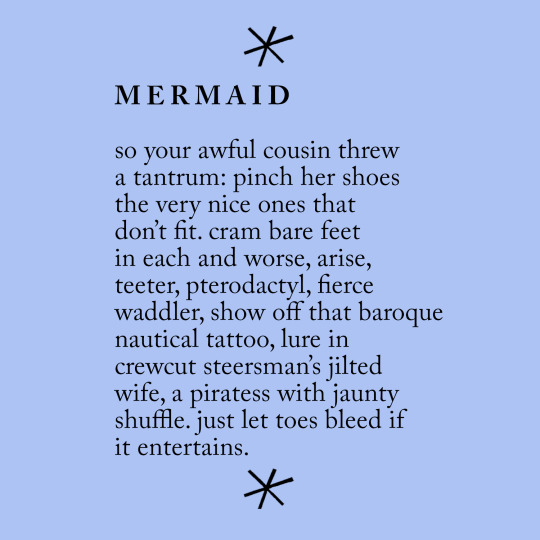
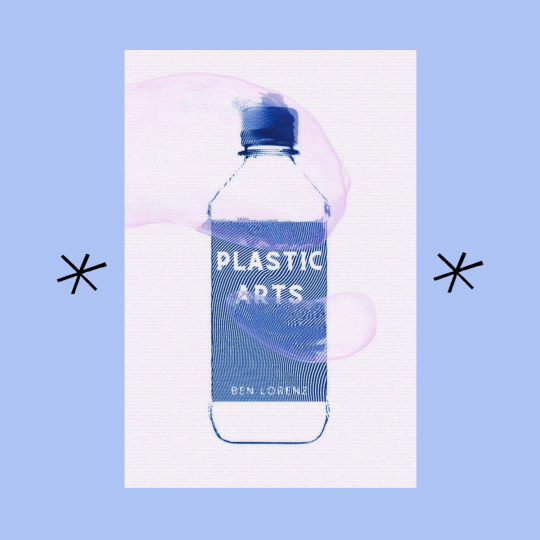
From Ben Lorenz's chapbook, PLASTIC ARTS, available from Bottlecap Press!
#amwriting#book#books#bottlecap press#chapbook#chapbooks#poem#poems#poems on tumblr#poet#poets#poets on tumblr#poetry#poetry community#poetry collection#poetry on tumblr#writing#writing community#writers on tumblr
75 notes
·
View notes
Photo
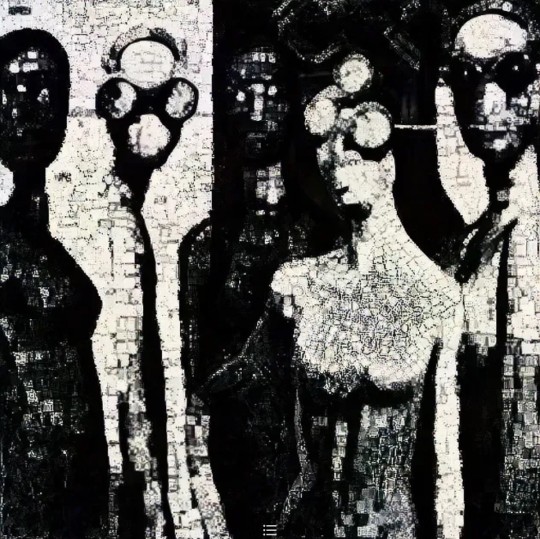

( via / via )
Eminent: Astro.
"The key thing to remember with literature is that it's a wholesale business as opposed to the visual arts, which is retail business." --Richard Kostelanetz in Atticus Review
A thread of poems that Aliza Grace has plagiarised, published, and is profiting from.
"Nine Skathons of Sxwaixwe"
#107
Sxwaixwe, they say, came from the union
of a garden slug
& a raven... Few have ever seen
his chartreuse scales, his
esplumoir; many have heard his laughter.
#108
Sxwaixwe laughs like a baby crying.
Sxwaixwe wears a tall
black silk hat, & lives beneath the Sound.
He has clairvoyance;
his cranium's tetrahedron-shaped.
#109
There is a book belongs to Sxwaixwe.
In it, he records
ev'rything that happens: past, present,
& future, but not
in any particular order.
#110
I saw Sxwaixwe once, walking backwards
in Pike Place Market
with his hat & his multicolor
coat. I watched him stop
& buy a vista of Mt Hekla.
#111
Sxwaixwe appears sometimes in your dreams
but only in part:
headless torso; wings & hat alone...
He is an omen
of erratic luck & weird events.
#112
Sxwaixwe gives oracles in Scrabble
takings you have to
anagrammatize yourself into
sense; visions seen
in oily puddles; shrieks of seagulls...
#113
Without Sxwaixwe we would have no fog,
espresso, leather
jackets, or yellow trees in autumn.
(Especially sacred
to Sxwaixwe is Caffe Medicí...)
#114
Squid-headed Cthulhu, Sxwaixwe, & the
Jesus of twoway
cards & Mexican gilt-framed icons
are siblings, slug-born,
but engendered by diff'rent Fathers.
#115
Sxwaixwe gave me this Form, to notate
my ruminations,
weave coincidences, & invoke
the spirits of this
gray-green crowded water-ruled abode.
(Seattle, 10/92)
40 Best Prince Covers.
0 notes
Text
4.3 Translating (into) acrostics or anagrams
Materials
• A source text or
• An acrostic (or mesostic) or anagram for translation or co-simultaneous heterolingual construction.
Examples
Co-simultaneous heterolingual construction of an anagram:
• Noel’s “I can’t breath/no puedo respirar” (Transversal 21)
From a source text not originally written in an acrostic or an anagram:
• De la Torre’s T20: “Translation of the poem smuggled inside another poem as an acrostic”; “T23: Anagrammatic translation permutating all the letters in the original Spanish into English language words”; “T24: Anagrammatic translation permutating all the letters in an English version of the original into Spanish-language words, and its corresponding translation into English” (Repetition 72-23).
0 notes
Text
al things considered — when i post my masterpiece #808
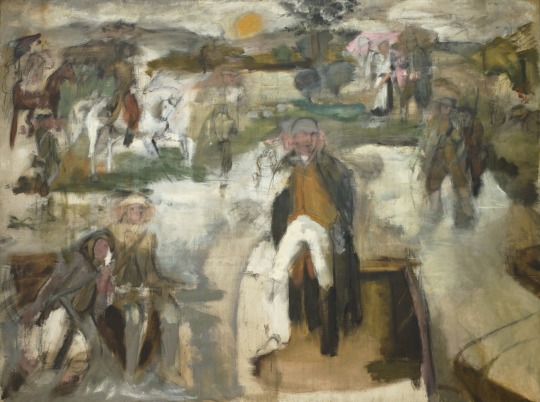
first posted in facebook february 28, 2020
larry rivers -- "washington crossing the delaware" (1953)
"to contemplate a piece of art or to create it, make love, even ... i knew no emotion never would equal one that came over to me when i was playing music" ... larry rivers
"a hard, howling, tossing water scene.
strong tide was washing hero clean.
'how cold!' weather stings as in anger.
o silent night shows war ace danger!
the cold waters swashing on in rage.
redcoats warn slow his hint engage.
when star general's action wish'd 'go!'
he saw his ragged continentals row.
ah, he stands – sailor crew went going.
and so this general watches rowing.
he hastens – winter again grows cold.
a wet crew gain hessian stronghold.
george can't lose war with's hands in;
he's astern – so go alight, crew, and win!" ... david shulman
"'washington crossing the delaware' is a sonnet that was written in 1936 by david shulman [...] the poem is noted for being an anagrammatic poem – in this case, a 14-line rhyming sonnet in which every line is an anagram of the title" ... wikipedia
“i think of a picture of a smorgasbord of the recognizable” ... larry rivers
"'delaware crossing the washington' ... is just babble written by al janik ... if it is noted at all, it suggests a reversal of proper nouns that get what they deserve -- in this case, a 29 letter anagram of the originAL smorgasbord ... no, it does not rhyme" ... al janik
#larry rivers#washington crossing the delaware#music#david shulman#george washington#delaware#anagrammatic poem#sonnet#wikipedia#babble#al things considered#smorgasbord
4 notes
·
View notes
Photo
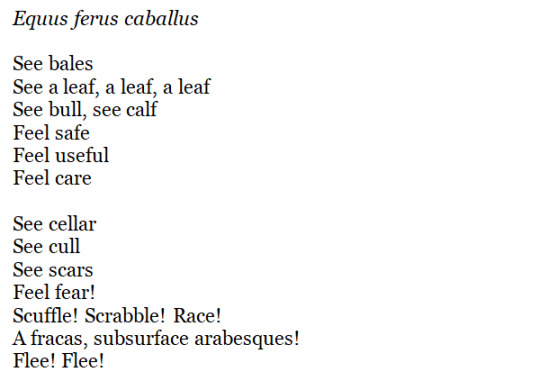

For Weirdtober 28: Horse/Farm animal horror
I think...doing some weird terrible ritual to give a horse self-awareness probably wouldn’t be a good idea. This is an anagrammatic poem and I would NOT have done it without scrabble helper websites. (All the letters in the poem come from the title.)
Transcript below readmore.
Equus ferus caballus
See bales
See a leaf, a leaf, a leaf
See bull, see calf
Feel safe
Feel useful
Feel care
See cellar
See cull
See scars
Feel fear!
Scuffle! Scrabble! Race!
A fracas, subsurface arabesques!
Flee! Flee!
Ear-see bell
Feel bell
Alas, alas!
See clearer, clearer
Feel cells
Feel fur
Feel self
Be self
A curse?
See…all
See cabal
See abuse
See fuel.
Be cure.
See us feral
See us rule
See us
7 notes
·
View notes
Text
Poem - Life’s Great Gulf
Life’s Great Gulf
Stature confirming beauty’s place
knowing all is as it should be
contentment gained in the end
sadness spurned by reality
refine impressions at heart’s dismay
as predilections have their say
acknowledging those surely blessed
still admiration may persist
divine impression restrained to sight
embrace artifacts hewed from life
to admire nature’s consequence
belying what could follow next
separated by life’s great gulf
admire the breadth of results
surety set by the frame
stature confirms beauty’s place.
© 2019. Sean Green. All Rights Reserved. 20191116.
The poem “Life’s Great Gulf” is an anagrammatic treatment of my poem “Beauty’s Place, with the original inspired by the stream of lovely photos in my Tumblr feed.
5 notes
·
View notes
Text
The Chimerical Creatures of Unica Zürn
The Chimerical Creatures of Unica Zürn
Unica Zürn a German author of anagrammatic poetry and artist of surrealist automatic drawings. Researching artists whose works intermix visual media with literature -especially that of poetry- I found Unica Zürn who utilizes the surrealist practice of “automatic drawing”, a process of expressing the unconscious through randomized movement of the artist’s hand. Zürn having died by suicide in 1970, her work was greatly influenced by her life a form of external expression, almost as if a form of escapism having suffered several forms of abuse from her mother and older brother, struggling with mental illness and being surrounded by suicides of those close to her and her longing for a closer contact with her beloved father who was absent for most of her life.
I was intrigued by her ornamental fantastical creatures with multiple appendages, eyes, melted forms, see through or linear bodies that showcase her haunted subconscious and vivid imagination. Though she briefly experimented with oil paint, her works were made primarily in Black India Ink simplistically colored with watercolor or colored inks. I enjoy that her pieces and her literary works compliment each other but can stand alone. The organic lines and ornamental motifs/shapes in her work remind me of Art Nouveau, Surrealism and Art Nouveau are a few art movements that greatly influence my work, Zürn’s work has made me reflect on past work when I had used similar media and focused on linear drawings with ornamental patterning to tryout the process of automatic drawing.
- Joley
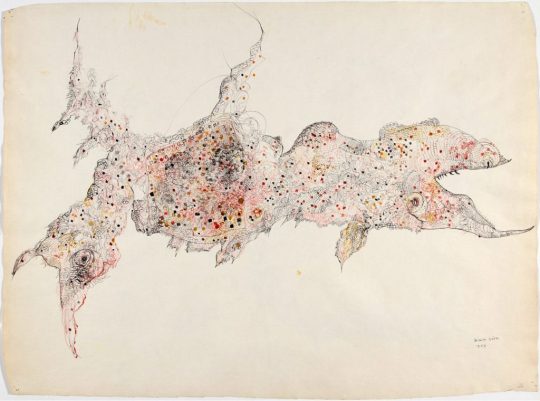
Untitled, 1959.
A STONE FOR UNICA ZURN
TWO HALVES: UNICA ZURN
UNICA ZURN: NINE ANAGRAMMATIC POEMS
#Joley #Submission
1 note
·
View note
Text
MESSAGIO GALORE TAKE XII
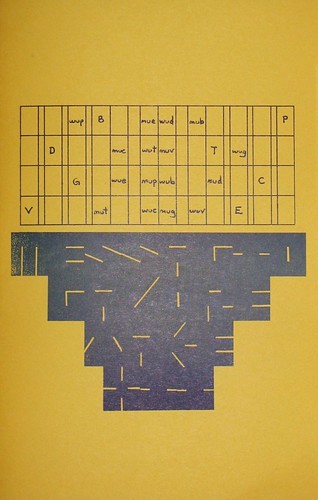
a duration of sound poetry & similaria
edited, reärranged & constraducted by jwcurry
& realized through the combined auditoria of
jwcurry Alastair Larwill Georgia Mathewson Brian Pirie
7 PM 21 octo 12 at Common Ground Art Gallery
3277 Sandwich Street, Windsor
___________________________________________________________________________
part 1
1. Scraptures: 12th Sequence, bpNichol (Canada, 1967?); source: photocopy from TORONTO LIFE (issue # & editor unknown, Toronto, 1968). & on the 12th "day", humanity stuck its heads up from the muck & goo, took a look around in its state of ignorant grace, & knew but lustful fear. arrangement dedicated to Jan Svankmeyer. full quartet
2. WELTWEHE, August Stramm (Germany, 1914); source: KROKLOK #3 (ed.dom sylvester houédard, London, UK, Writers Forum, 1972). Stramm’s scope is nothing less than cosmic in this, his most extreme narrative composed almost solely of verbs, fuelled & shaped by the battlefields he wrote in & the ciphers he wired his poems home through. solo
3. SIX-FOUR, Alastair Larwill (Canada, 2o1o); source: unpublished manuscript. accumulative disintegrational polysyllabicism formulated as an audio illustration in a discussion of articulational deliberateness with its dedicatee, Rob Read. full quartet
4. Generations, bpNichol (Canada, 1988); source: bpNichol, gIFTS The Martyrology Book(s) 7 (&) (Toronto, Coach House Press, 199o). Nichol’s numerical interpolations distract & enact a simultaneous metanarrative between his given text & what’s given through his interferences with it. solo
5. Againful Deployment, jwcurry (Canada, 1981?); source: monograph (Ottawa, 1cent, 2oo1). a "sound poem for an assemblyline of voicings" spiralling outta the conch into yr cochnea. full quartet
6. Salmon River Soliloquy, David UU (Canada, 1973); source: David UU, High C (Toronto, Underwhich Editions, 1991). a rather straightforward poem siding with the fishes. solo
7. anacyclic poem with two shouts DHARMATHOUGHTS STUPAWARDS, dom sylvester houédard (England, 1966); source: KROKLOK #1 (ed.dom sylvester houédard, London, Writers Forum, 1971). "for the artists protest committee for their call from losangeles for a tower against the war", an anagrammatic poem in 3 vowels & 4 consonants. duo: curry/Mathewson
8. " BREATH IS ", bill bissett (Canada, 1966?); source: bill bissett, fires in th tempul OR TH JINX SHIP ND OTHR TRIPS (Vancouver, Very Stone House, 1966). one of bissett’s concrete scattertexts, here divided into a demonstration of the logic inherent in his more radical field compositions. duo: curry/Larwill
9. Oiseautal / Super-Bird-Song, Raoul Hausmann (France, 1918?) & Kurt Schwitters (England, 1946?) respectively; source: Raoul Hausmann & Kurt Schwitters, PIN and the story of PIN (London, UK, Gaberbocchus Press, 1962). brought together by the 1st world war & separated by the 2nd, both friends independently came to write short works based on birdsound. this interlineated arrangement by curry (2oo9?) is a step toward A Visit to the Aviary, a short suite of related material from various sources. duo: curry/Pirie
1o. THREE/FOUR: OF TIME, bpNichol (Canada, 1985); source: 5e echanges internationaux de poesie contemporaine, ed.Julien Blaine (Tarascon, France, L’A.G.R.I.P.P.A., 1988). the 3rd in Nichol’s "TIME" series "for the 4 Horsemen", this one targetting the structure of the waltz for vigorous interrogation. full quartet
11. Calling The Vegetable Collected, jwcurry (Canada, 2oo8); source: monograph (2nd ed, Ottawa, 1cent, 2oo8). hocketed statements that build multiple syntactic paths as the fragments first cohere, then disintegrate. full quartet
12. GLiNE OR EXTRATERRESTRIAL OCCURRENCES, Vaughn Bodé (USA, 1972?); source: Vaughn Bodé, JUNKWAFFEL no.3 (Berkeley, The Print Mint, 1972). Bodé’s 5pp comic relieved of its graphic anchor, its text no less rich in its significtions despite the lack of signposts. solo
13. KNOTS, jwcurry (Canada, 1982?); source: The (Almost) Instant Anthology ’88, ed.Beverley Daurio, Daniel Jones & bpNichol (Toronto, Meet The Presses, 1988). excerpts from a "translation into concrete poetry" of R.D.Laing’s lineated neuroses trackings, subsequently unreknotted & strung out as a schizologue for 2. duo: Larwill/Mathewson
14. The Tibetan Memory Trick, traditional/arranged by Howard Kaylan, Ian Underwood & Mark Volman (USA, 1974); source: Flo & Eddie, ILLEGAL, IMMORAL AND FATTENING (Canadian pressing, Columbia Records Limited, 1975). spontaneous insertion into KNOTS above. everyone in the band gets put through this one for articulational, breathing & body memory development. full quartet.
15. AGATHA! WAKE UP! I’M CURED!, Richard Beland (Canada, 1992?); source: unpublished manuscript. Beland’s language lines are as plastic as his visual lines, this short prose morphing from sense to sound to resense with every step. solo
16. MUSHY PEAS, Steve McCaffery & bpNichol (England, 1978); source: Steve McCaffery & bpNichol, IN ENGLAND NOW THAT SPRING (Toronto, Aya Press, 1979). 6 pp of drawn optophonetics as visual field for improvisation. duo: curry/Larwill
17. sounds’ favorite words, Paul Haines (Canada, 1986), as quoted in full in an extract from Haines’ Jubilee; source: Paul Haines, Secret Carnival Workers (Toronto? H Pal Productions, 2oo7), with reference to Michel Contat’s reading on Haines’ DARN IT! (USA, American Clavé, 1994). hijacked as a footnote of manysorts. Jubilee ends "Unrelatedly, there was a recital of whisk the morning of 17 July after a night the cats had raised hell on the front lawn, a group of robins fallen by the side of the hedge as though meeting on a street corner and – now headless to prove it – plumb run out of things to say, but still prettier representations of events than the sparrows the exact size of erasers stacked up with the heads on. // Which of course are words apart." solo
part 2
18. TOTEM ÉTRANGLÉ, Antonin Artaud (France, 1964?); source: KROKLOK #2 (ed.dom sylvester houédard, London, Writers Forum, 1971), with reference to Antonin Artaud/trans.Helen Weaver, Selected Writings (New York,Farrar Straus And Groux, 1976). "For years I have had an idea of the consumption, the internal consummation of language by the unearthing of all manner of torpid and filthy necessities." (Artaud in a letter to Henri Parisot, 22 sep 45). 18 of these sound cycles excised (by Artaud) from elsewhere in his writings (Here Lies; Insanity and Black Magic; The Return of Artaud, Le Momo; To Have Done with the Judgement of God; Van Gogh, The Man Suicided by Society) & formally linked as a suite. full quartet
19. ma meeshka mow skwoz, Mike Patton (USA, 1995); source: monograph (San Francisco, privately published, 1995), with reference to Mr.Bungle, disco volante (USA, Warner Brothers Records Incorporated, 1995), with music by Trey Spruance. Patton’s drawn optophonetic text yields "extended range" vocalics that’re all but buried in this complex piece of high-impact chamber music. a chance to hear the relentless trajectory of the text on its own. solo
2o. East Wind, bpNichol (Canada, 1979?); source: Four Horsemen, The Prose Tattoo (Milwaukee, Membrane Press, 1983). a gridtext deployed through overlaid extended breathlines, vowels blowing consonants all over the place. full quartet
21. The Multiples, Steve McCaffery (Canada, 1981); source: abs TruCt heh GarBagt, editor unknown (an insert in CABINET #1, USA, Immaterial Incorporated, 2ooo), transcribed by Rob Read (Canada, 2o11?). a multiplicity of mispronuncimicated masticatiums of eaneming, the contrast between what you seam to be hearing & what are here seming to be. duo: curry/Mathewson
22. A Letterklankbeelden Poem, I.K.Bonset (Holland, 192o); source: Imagining Language An Anthology, edited by Steve McCaffery & Jed Rasula (2nd ed, Cambridge, USA, MIT Press, 2oo1). with line lengths (mainly) one letter long, Bonset – among other things, a type designer – was simultaneously & independently investigating notions of optophonetics similar to Raoul Hausmann’s with diacritic modifiers. terse. solo
23.SIZERZ, Steve McCaffery (Canada, 1976); source: THE CAPILANO REVIEW #31 (ed.Steven Smith & Richard Truhlar, North Vancouver, 1984). severe elemental hocketing coupled with ordered layerings subjected to consistent randomizations. full quartet
24. roses that, d.a.levy (USA, 1966); source: UKANHAVYRFUCKINCITI BAK, ed.Robert J.Sigmund (Cleveland, Ghost Press, 1968). "for gene" (presumably Fowler), a cyclic concrete poem in linear form pumping ackackfire into the imperialism of semantic politics. solo
25. IT CAN’T HAPPEN HERE, Frank Zappa (USA, 1964); source: Mothers Of Invention, FREAK OUT! (USA, Verve Records, 1965), transcribed & arranged by jwcurry (2oo7). a somewhat remented barberchopping routine that only seems to leave metre & tonality behind, part 2 of Help, I’m A Rock, featuring Georgia Mathewson as Suzy Creamcheese ("You blew your mind on too much koolaid"). full quartet
26. BALLADS OF THE RESTLESS ARE, bpNichol (Canada, 1967?); source: monograph (2nd ed. Ottawa, Curvd H&z, 2oo6). "two versions/common source" of elemental theme & variations presented as comparative simultaneities in a "quartet for 2 voices" [curry]. duo: curry/Larwill
27. A Little Valentine, Steve McCaffery (Canada, 1977); source: Steve McCaffery, research on the mouth (Toronto, Underwhich Editions, 1978?), transcribed & arranged by jwcurry & Sheena Mordasiewicz (2o12). a trystcycle built for 2 interpenetrates itself to become a relentless rush toward simultaneous climax. duo: curry/Larwill
28. Pieces Of Stop, bpNichol (Canada, 1978); source: as 2o above. "for Greta Monach", an extremely literal approach to the score that casts the reversed expectations of its sound envelopes into stark relief. full quartet
29. auf dem land, ernst jandl (Austria, 1968?); source: konkrete poesie deutschsprachige autoren, ed.eugen gomringer (reprint? Stuttgart, Philipp Reclam, 198o). an "utter zoo" octupletted & arranged as simultaneous nouns’n’sounds. duo: curry/Larwill
3o. GLASS ON THE BEACH, Richard Truhlar (Canada, 1978?); source: Owen Sound, Beyond The Range (Toronto, Underwhich Editions, 198o), transcribed by jwcurry from a trio (Michael Dean, Steven Smith, Richard Truhlar) recording at The Music Gallery in Toronto, 18 august 1979, with additional parts adapted from 2 manuscript scores courtesy of Truhlar. extended vocal waveforms with buried shards. full quartet
___________________________________________________________________________
with Big Thanks to Gustave Morin for causing it, Jenny Kimmerly for the programmes, Jarrod Ferris for filming, Kung To for rehearsal space, Chris (dunno yr last name) & Sergio Forest for the fantastic homemade onion rings &, ‘fcourse, the band for the pleasure & hard work
front cover: bpNichol, Pieces Of Stop (28), rescored by jwcurry (bottom: lettering by curry)
rear cover: dom sylvester houédard, anacyclic poem with two shouts DHARMATHOUGHTS STUPAWARDS (7)
___________________________________________________________________________
see also:
announcements:
www.flickr.com/photos/48593922@N04/8078983925/
www.citywindsor.ca/residents/Culture/Mackenzie-Hall/Pages…
pagehalffull.com/pesbo/2012/10/12/sunday-oct-21-messagio-…
issuu.com/uwindsorlance/docs/thelance-85-16 (down on p.6)
www.flickr.com/photos/48593922@N04/8152980663/
photographs:
www.flickr.com/photos/pearlpirie/8119045118/
www.flickr.com/photos/pearlpirie/8119033749/
www.flickr.com/photos/pearlpirie/8119034091/
www.flickr.com/photos/pearlpirie/8119046498/
www.flickr.com/photos/pearlpirie/8119034923/
2.bp.blogspot.com/-utKD_y6vO8c/UIgX0FXlbYI/AAAAAAAAAL8/kA…
Posted by jwc 3o2 on 2012-10-31 04:32:03
Tagged: , quadrabet
The post MESSAGIO GALORE TAKE XII appeared first on Good Info.
0 notes
Photo

Ambroise Lefurgey: Selected Poems. Translation and Foreword by Liesl Ketum. gnOme, 2017. 80pp.
Lefurgey was a metaphysical wayfarer, a poet-sage who lived his life on the razor’s edge. A walking coincidentia oppositorum, he threw himself full tilt into the Moebius simultaneity of worlds both sacred and profane. Enigmatic and dreamlike, yet not without a recurrent insistence on embodiment, his surreal poems flicker as hot coals do, often flaring between themes of eternity and facticity, body and spirit, love and lovelessness.
“Lefurgey’s poetry—a light / so bright it blinds my eyes / Alive! / Alive! / Alive! / (I’ve died!)” — Daniah Chilcott, director of Le Trident Barattage(from a 1938 critical-creative review first published in VERBANA, the famed Surrealist art journal)
“The translation of a poem by February Eglomise had been floating around the island of Montréal during my undergraduate years in that city; it was entitled ‘A Lifebuoy’s Merger’ and had to do with the alchemical process—indeed, it was said to have divulged the great secret of tinctures, and by dint of this many believed the poet to have been a student of Jean-Julien Champagne, a.k.a. Fulcanelli. The original from which ‘A Lifebuoy’s Merger’ had been translated was a document no one could find. It is fitting, then, that a student in anglophone Toronto—at the so-called ‘Divinity School’ (a.k.a.School of ‘Divining-Rods’ qua ‘Plumbing-Techniques’) of Toronto’s Humber College—plumbed the depths of this mystery and discovered that both the name of the poet (February Eglomise) and the name of the poem (‘A Lifebuoy’s Merger’) were anagrams of Ambroise LeFurgey (and of course, vice versa). Mike Tulles, Humber College’s top-notch student of plumbing-techniques, anagrammatized his name and then published his findings under this «nom-de-plumb»—a publication that took the form of the present pseudonymous translation (plus prefatory introduction) of an unanagramatized French poet. In order to disguise his institutional affiliation, he simply added an asterisk-dagger to Humber, creating in so doing Humber† College and its ‘Divinity School’ student Liesl Ketum. Lest it be said that I here break pseudonymies, it should be added that Mike Tulles a.k.a. Liesl Ketum might in fact—in reality—be Ellie Muskt (yet another anagram), and that the latter and all of the former might be the daughter (and/or son) of a certain Maye and Errol, to whose surname another asterisk-dagger was added. The mysteries and mysterious/pseudonymous interconnections go on and on and on. In this space—in the space of these plural/plurifold pseudonymies—let me simply suggest, in fine gnOme_Books fashion, that the translator and translated can be signed (either one) as Space-X.” — M
3 notes
·
View notes
Link
IN 1979, FOR A LECTURE at the opening of his Walker Art Center exhibition, artist Ray Johnson streaked (as in ran naked) down the aisles when he was introduced. This act was a reference to another Ray Johnson (no relation) who had recently streaked at the Vatican, causing him to be expelled from Italy back to Connecticut, where the two Johnsons met each other at the Wadsworth Atheneum. This mix of wordplay, coincidence, and absurdity characterizes Johnson’s entire body of work, which includes collage, mail art, and performance. While his art incorporates such wild, grand gestures highlighting the incongruity of daily life, it also encompasses the intimacy of writing personalized letters to strangers. Johnson’s art is layered with texts and references; his mail art project involved thousands of solicited and unsolicited letters, notes, and objects sent and received over decades. Johnson was ultimately interested in the successes and failures, the gaps, the misunderstandings and slippages in human communication.
His interview practice fits squarely within this concern. For someone whose whole life was a performance, it’s no surprise that he did not conduct traditional interviews. Always interested in the layers of communication, the possibilities of intimacy and distance, and the ability to rewrite and reconstruct history, Johnson’s every answer and pause came freighted with meaning. This is especially evident in Julie J. Thomson’s selection of interviews, That Was the Answer: Interviews with Ray Johnson. The book spans 1963 to 1987, including previously printed interviews from magazines and others transcribed from audio, never before published.
Each interview is unique and designed specifically for the interviewer. As Johnson explained to Detroit Artists Monthly creators Diane Spodarek and Randy Delbeke in 1977: “Everything I make is made for the person I’m writing to — there is a whole daily process of what the envelope enclosure is to be, how it is folded, what is enclosed, what the envelope is, what the style is, whether it is very casual or very formal.”
This intimacy is just as much a part of his works as the absurdity of the “Mickey Mouse” or “bunny” glyph he would stamp on them. Even in the cases where he would write to celebrities, art dealers, and other figures he’d never met, each work was crafted just for them. “[W]hat I do is made for each person,” he said. “When I’m speaking to you, I am creating this composition for you by telephone, on the spot.” This methodology extended into everything he did, even and especially his interview practice. When photographer Richard Bernstein traveled to Johnson’s Locust Valley home to cover him for Interview magazine, Johnson remarked: “Of course you’ve noticed that there’s no furniture in the house, because when people come to visit me I spend two days hiding everything and then I do these arrangements. I take what little furniture I have and make little works of art.”
For Bernstein, he made “about twenty-four separate arrangements which no one will ever see; which only I know about, and which will never be documented.” Johnson acknowledged no division between his life and his art; everything was an opportunity to perform correspondence.
cor-re-spon-dence n.
Communication by letters.
Answering to each other in fitness or mutual adaptation; congruity, harmony, agreement.
Johnson’s work makes us rethink definitions. His extensive epistolary practice, collage work, and lectures expand what it means to correspond. To the artist John Held Jr., Johnson defined his correspondence as “a giving, but it’s also a distribution and a planting and a seeding, and it takes time”; he went on to note that he has “demonically pursued the subject.” His process of working and making mailings was exhaustive. “It’s like prayer, it’s a ritual for me, a ceremony,” he explained to Spodarek and Delbeke. The ritual included gathering his mail from the mailbox, turning on the television (to listen to it, not to watch), and drinking coffee, as he “surgically insert[ed] the knife in these envelopes” and sorted through them, always working his way down from the top to the bottom of the pile.
His process was not the traditional receive-and-reply of letter-writing: his replies were often sparked by some play on words, some correspondence between things on the page or in life — like his nude homage to the other Ray Johnson. Johnson tells art critic Henry Martin why he responded to a man who sent him a book of his poems:
I’ll ping-pong back to him and do a whole Belt Club about him, because of his name, which is Beltrametti, he’ll be the Spam Beltrametti Club, just like Cavellini got into some of my caveman collages because the first four letters of his name are CAVE. There’s a reason to write to him, to thank him for his book, but also he gets involved in other things because of some combination of alphabetical letters and names.
Johnson had already created the Spam Belt Club, of which this name reminded him. His art is an art of associations, an endless linking together of words, images, and people, a chain of correspondences.
As he tells Bernstein: “My reason for being interested in people is their anagrammatic names. Since I cut everything up, they’re all people in a kaleidoscope, but one person is many-faceted, like a crossword puzzle.” Kaleidoscopes recur throughout his interviews and serve as a fitting image for his thinking: fixed objects with pieces that can be rearranged by a slight turning, like his collages that he would often revisit and rework years later. As he put it: “The Correspondence School is related to the collage work and all these images, conversations, associations, complexities of what for me I’m trying to make some meaning out of.”
com-mu-ni-ca-tion n.
The fact of having something in common with another person or thing; affinity; congruity.
Interpersonal contact, social interaction, association, intercourse.
So what is the meaning that Johnson’s correspondence attempts to communicate? His physical works and performances play on our assumptions. In the introduction to his interview included in the book, Martin recalls something Johnson once said: “[T]hese collages are really like playing cards, and everybody gets a different selection […] [T]hey’ll bring up other people and images and ideas.” Each was made for one specific person, and each person brought his or her own interpretation to the arrangement of images and words. “[T]here’s a whole history, then, of objects that have been actually mailed or presented or delivered,” Johnson tells Martin. Many of his collages include the phrase “Please send to” with the details of a future recipient he hoped the objects would reach. “[T]his is a part of what I call the Correspondence School because these objects are things that are exchanged for some reason […] [T]here was a kind of communication between these objects, a kind of communication of objets trouvés.” As the objects moved, they were transformed through contact, with each sender adding to the piece or removing from it.
Following his interest in names and people, from Marilyn Monroe and Greta Garbo to Gertrude Stein and Joseph Cornell, much of Johnson’s collage work takes the form of portraits. “That’s what these portraits are all about,” he explains to Spodarek and Delbeke. “They are all the interior of the head. I’m trying to depict what goes on in the interior of the head: thoughts, images, or ideas.” There is an interiority to his communication as well: it’s not just about an exchange between objects but also a communication of internal thoughts and associations, of the Freudian slips we think but try to mask. In a 1984 radio interview, Weslea Sidon raised the issue of Freudian slips and purposeful slippage, “to catch an unconscious process and make a decision to do it, to use it.” “Well maybe that’s what writers or poets do,” Johnson responded. Despite his extensive use of text and wordplay, Johnson eschewed the label of poet: “I shouldn’t call myself a poet but other people have. What I do is classify the words as poetry.” Poetry is an apt model for Johnson’s communication, though, since his words, images, and symbols require a deep unpacking of possible meanings.
What about the social aspect of communication? While his mailings offer a model for sociability, they aren’t exactly a social interaction. His performances and lectures (which were usually more akin to performances than traditional talks) use many of the same models I’ve noted — i.e., wordplay and free association — but they also involve a more immediate social interaction with the audience or other participants. On the day of his lectures, he would look to his morning mail for inspiration, finding something during his ritual opening of letters to use in his talks, whether it be something to wear or to hold. “I’m dealing with magic,” he told Spodarek and Delbeke. “I provoke the mailbox to provide me […] Or, I will use what is in the mail for the subject of my lecture.” Pieces, sometimes from strangers, would become essential elements in his communication to that day’s audience, adding an element of chance to each lecture and making each event a one-off occurrence.
in-ter-view n.
A meeting of persons face to face, especially one sought or arranged for the purpose of formal conference on some point.
Looking into; inspection; examination.
But Johnson also upends communication by playing with its failures, the nothings and silences that communicate so much but are often hard to interpret. This brings us back to the interview format, a technique of communication — a social interaction — but also a kind of correspondence. And Johnson performed it much as he did everything else. In a 1968 oral history interview for the Smithsonian Archives of American Art, Sevim Fesci begins by asking about Johnson’s background, where he is from and when he was born, to which Johnson replies: “I find whenever one begins a tape like this that it doesn’t get interesting until you’re into it […] And your beginning questions prompt a certain silence.” As with his rearrangement of furniture, Johnson never approaches an interview as a blank slate awaiting questions; he always has a performance in mind. As Martin notes: “He explains himself only in the very same ways that he expresses himself, and getting an interview from him means accepting potluck.”
The transcript of a second 1984 radio interview, with Shirley Samberg, is filled with “[pause]” notations. After the first occurrence, Johnson tells Samberg: “This is something I planned hours ago. That I would create spaces in reply to questions. Or in reply to logic. As I’ve done here. I’ve just created a sort of a rectangle with nothing in it.” A rectangle of nothing evokes a series of performances — happenings — that Johnson gave throughout his career. A student at Black Mountain College at the same time as John Cage tenure there, the most famous artist of nothing, Johnson was similarly interested in these blank spaces and pauses. As Thomson notes in her introduction, “Johnson’s emphasis on, and inclusion of space, allowed it to become an active part of his work.” She draws attention to this moment in the Samberg interview, as well as to the moment during his Archives of American Art interview when, asked about time in his work, Johnson paused to smoke a cigarette and then explained: “By the way, that was the answer to your question about time.”
In his interview with Held Jr., Johnson describes an appearance he made on a talk show:
They thought I wanted to sit and talk and present, and they set up the camera and the background, and so forth. But what I was doing was action in the outer edges, and I began moving, physically moving everything, which is like a recurring theme of my lectures, which is to set everything in motion.
Even in his blank spaces and nothings, Johnson is working around the edges of what we presume an interview to be, forcing us to rethink our roles. If every question becomes a prompt for an artwork, the interviewer becomes a participant in an ongoing performance. At one point, while speaking with artist and longtime correspondent Richard Pieper, Johnson claims that many of his performances are not conceptual art but rather “participatory action. I keep saying to people who want to find out about the Correspondence School that the only way to truly understand it is through participation, because what I do is made for each person.” In his interviews, Johnson offers a chance to participate, correspond, and communicate, in the fullest meaning of those terms.
¤
Megan N. Liberty is an arts and culture writer based in Brooklyn. She is the Art Books editor at the Brooklyn Rail and has a master’s in Art History from The Courtauld Institute of Art in London.
The post Ray Johnson’s Kaleidoscopic Interview Practice appeared first on Los Angeles Review of Books.
from Los Angeles Review of Books https://ift.tt/2P9FU4R
via IFTTT
0 notes
Text
(flawed) pirate
pirate
eat a ripe peaa tripe pierip pear apartat a piera rapt riterat trap patterair arttip irate paterapt prat tripretire
By Kim M. Russell, 9th November 2023
Image by Patrick Pahlke on Unsplash
Björn is our host for Meeting the Bar at the dVerse Poets Pub and he invites us to play with limitations in poetry.
Björn has introduced us to a poetic form (or set of rules) created by Canadian…

View On WordPress
0 notes
Photo

Sweethearts
Emmett Williams
A founding member of Fluxus and the concrete poetry movement, Emmett Williams (1925-2007) made several performances and poems that stand today as defining gems of those genres. Among them is the book-length concrete poem Sweethearts, first published by Something Else Press (where Williams was editor in chief) in 1968, and back in print for the first time, still sporting its classic cover by Marcel Duchamp. Sweethearts is an anagrammatic erotic encounter between a "he" and a "she," whose entire vocabulary is derived from the word "sweethearts." The letters maintain the same spacing in every word on each page, lending the volume a flipbook dimension that Williams enhances by organizing the text to read backwards, so that the reader can flip the book with her or his left hand (thus the front cover is on the back, and vice versa). Richard Hamilton described Sweethearts as being "to concrete poetry as Wuthering Heights is to the English novel... compelling in its emotional scope, readable, a sweetly heartfelt, jokey, crying, laughing, tender expression of love."
0 notes
Photo

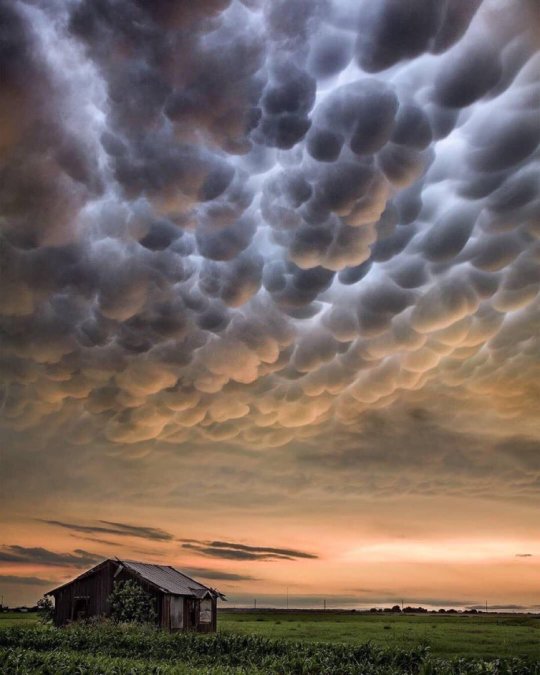
( via / via )
The Mosaic Effect.
"Anagrammatic Sestina
At the end of the furrow, words staple
the page, lashing agile lines. None are spared.
The choice is made: it imbricates, recaps
white porcelain, tin, polishes carets,
better yet, china clay. Rhyming words, ternes
bearing sludge with vestiges of tinsel,
grown gloomy, kiss-crazed by a queen’s intels
caressing your collar like worn petals,
your anagram arrives—this time it’s 'treens'—
in place, on the fingertips of padres.
A doctored line, but baited with caster:
to catch and serve a salad with capers.
This one’s beauty spot is made of black crapes,
but smelling of resinous log, elints,
like the other’s pale eyes, hollowed-out crates,
and the poem shows the skull’s tempest (plates
shift within pate) ejecting seaweed spread.
The meaning that’s reflected there enters,
broke, with no clincher. It is no nester.
Form has its reasons, and for a parsec
I will uphold this, though my nerves be rasped.
The line uncoils along coves and inlets,
serene—voice, paper, color, smooth as pelt.
A rush of dull hemoglobin reacts.
If permutation of final traces
ferrets out ideas that are tenser,
spawns some innovative shade of pastel
(lyric vocab), suddenly a spacer
also appears. The line tries to enlist
readers who feel as vapid as ad reps,
enthralled, recruited by syntax not parsed,
non sequiturs. But a mermaid caters
not to fresh water. She will not listen
to unrhymed rhymes’ nebbish bid to renest.
Unsalted, they’d be weak as tea, pacers
and bellwethers no more, at their palest.
After you had read the pleats in the drapes,
I, haunted, sought to scrape thoughts not recast,
squeezed, or resent by a voice now silent."
--Jacques Jouet (tr Rachel Galvin)
"For anyone who’s intimately familiar with both, there are clear parallels between musical synthesis and transgender hormone replacement therapy (HRT)." (via Mefi)
"The vices of the intellect are perilous, and what a ruin of a nature there is in a gift improperly used, for the mind is the lair of the lurking pard's tooth." --Dahlberg
Smells Like Team Spirit.
0 notes
Text
Delusional onset
I said I’d lose it
I told no solution
Sensational lesion
Tenant assassination
A student’s seasoned
No salt to steal
Not lust, see sense
A lion’s no seal
So settle in tense
And let illusion
Use and loosen
Senile old union
Denial all sins
Little sold, no one lends
One loan and it’s dead
Send
Send
Send
Sent
2 notes
·
View notes